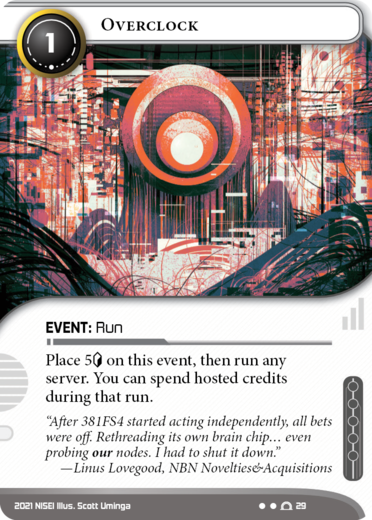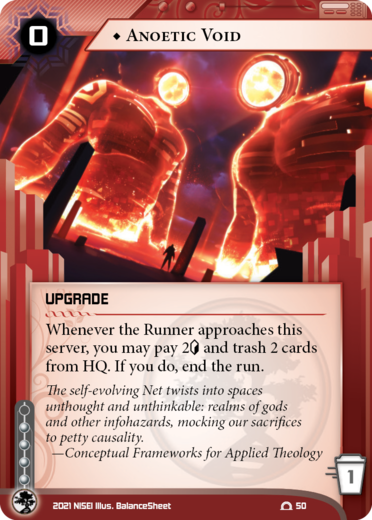System Gateway will mark the release of new cards to shape the game’s core experience and the rotation of some older staples. Zoe Cohen and Keith Gaudry of NISEI’s Development team are here to walk through some of those changes and explain how power is being placed into specific types of effects.
Zoe:
Some of the biggest scoops about System Update 2021 are about what’s not included. Headlining that list is Stimhack. Stimhack is leaving Standard.
And that has some pretty far-reaching implications with respect to the competitive landscape. Way back during Uprising development, I applied to join the Development team from Playtest. During that process, Dave (NISEI Lead Developer, aka divadus) asked me about cards which curtailed the viability of otherwise-healthy strategies or factions, and I identified Stimhack as one of the most quietly warping cards in the pool. When it came time to start putting together System Update 2021, we playtested an environment without Stimhack to see if this perspective was backed up by evidence.
To be clear up front, I don’t think Stimhack-type effects are inherently broken, or even that Stimhack was ever so egregious as to warrant a ban. It’s just a strong card, but it doesn’t always need to be this efficient or flexible. At 1 influence, Stimhack went in every deck. The value it provided to Shaper especially limited design space for in-faction economy. When you check out my interview on The Shadow Net during Community Week, you’ll see some of the other ways we’ve chosen to put power into Shaper.
Stimhack was also so powerful that if your plan wasn’t compatible with taking brain damage from it, the best move was usually to change your plan. Even with Supercorridor, this issue alone was enough to bar Lat: Ethical Freelancer from competitive viability, for example.
In place of Stimhack, we’re introducing a new, neutral run event in System Gateway. Like most neutral cards, this is not the ceiling for this effect, just a baseline that all factions can exceed in their own ways. This card really shines in the Starter Decks, where it goes a long way towards keeping our streamlined money-and-breakers introduction dynamic and exciting. We hope that this card will become iconic in its own way, creating memorable moments in players’ first games, and on merit of this stunning illustration by Scott Uminga. Introducing Overclock.
A simple look at the difference between the two cards might suggest that System Gateway heralds a powered-down Standard, but that couldn’t be further from the truth. Instead, we’ve been very intentional about putting that power level in the places that produce the most interesting and dynamic results. My teammate will expand on that with our second spoiler.
Keith:
Given that we’ve just talked about where we’re removing some of the power from the card pool, it’s only fair that we talk about where we’re putting it. One of our key balancing tenets is that the emphasis should be on cards that proactively advance your gameplan. For the Corp, that usually means flatlining the Runner or scoring agendas. Jinteki, more than any other Corp, has a history of using powerful upgrades to help keep the Runner out of their scoring remotes. Without further ado… Anoetic Void.
First of all, look at that amazing art by BalanceSheet. He knocked it out of the park with this and some of the other Jinteki cards, and I hope we get to see more of his work in the future.
I think the best place to start with this card is the obvious comparison: Caprice Nisei. A powerful tool to protect a server in the face of a Runner that can break your ice, Caprice defined the game for a long time. While the exact implementation isn’t always fondly remembered, we strongly believe that giving players strong tools to enable their game plan is important to the health of the game. With that in mind, the Dev team paid a lot of attention to this card throughout the development and playtest process because we wanted to make sure we got it right. While the core design stayed relatively consistent throughout the iterations we tested—it was always a cheap-to-trash upgrade that outright ended the run—the adjustments we made and variants we tried highlight a few of the noteworthy facets of this card.
The development of this card largely revolved around the cost of its effect, which hasn’t been explored much in Netrunner. Sure, a few Weyland cards, like Audacity and Election Day, trash HQ in its entirety to pay for an effect, but picking and discarding cards in HQ as a cost isn’t well-trodden ground. The first version of the effect was:
Whenever the Runner makes a successful run on this server, you may trash 3 cards in HQ to end the run.
This proved to be an overly steep cost, considering how much discarding 3 cards can disrupt a Corp player’s game plan. When we reduced the cost to only 2 cards, it was a little too easy to end the run two to three times in a single turn! We considered a number of adjustments to rein in that version, including a much higher rez cost and limiting the ability to one use per turn. In the end, we decided that the final version, which costs both 2 cards and 2, kept an exciting potential for that very powerful turn, but made you pay an appropriate cost for the effect.
An uncontestable “end the run” is a powerful effect, but having to pay in both credits and cards in hand can be a large burden, and it’s not as if the Runner can’t fight back. Along with the usual ability to trash Anoetic Void out of central servers, trashing and stealing cards in HQ can limit the Corp’s ability to use it, giving Runners a unique way to fight back.
Between Anoetic Void, Hansei Review, and even beyond System Gateway, I hope you’ll enjoy the new twist of Jinteki caring about cards in both players’ hands.
Balancing the game is a delicate process, since no change is made in a vacuum. We hope this gives you a taste of some of our considerations as we developed System Gateway and prepare for sets beyond.
System Gateway and System Update 2021 will be released on or shortly after March 28, 2021, as physical cards via NISEI’s print-on-demand partners and pay-what-you want files for downloading and printing at home!


